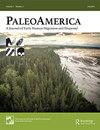Cueva Maripe遗址(阿根廷圣克鲁斯)全新世早期的遗址内利用模式
IF 1.7
Q1 ANTHROPOLOGY
引用次数: 3
摘要
本文对位于阿根廷圣克鲁斯省(巴塔哥尼亚)的多活动遗址Cueva Maripe最早考古成分(早全新世)的空间格局进行了定量分析。我们在地理信息系统环境中工作,将挖掘的模拟和数字信息系统化,包括已登记的壁炉的位置,石器文物和骨骸的频率,以及燃烧材料的分布。可视化技术和空间统计使我们能够定义站点的内部结构。结果表明,Cueva Maripe可能被用作短期临时营地。这种空间方法可以更好地理解场地的形成和占用历史,也可以比较场地之间不同的场地内部使用模式。本文章由计算机程序翻译,如有差异,请以英文原文为准。
Intra-Site Use Patterns during the Early Holocene in the Cueva Maripe Site (Santa Cruz, Argentina)
ABSTRACT In this paper, we make a quantitative analysis of spatial patterns for the earliest archaeological component (early Holocene) at Cueva Maripe, a multiple-activity site located in Santa Cruz province (Patagonia, Argentina). We worked in a geographical information systems environment to systematize the analogical and digital information from excavations including the location of registered hearths, the frequency of lithic artifacts and bone remains, and the distribution of burnt materials. The visualization techniques and spatial statistics allowed us to define the intra-site structure of the site. Results suggest that Cueva Maripe was probably used as a short-term temporary camp. This spatial approach leads to a better understanding of the formation and occupation history of the site, as well as a method for comparing different intra-site use patterns between sites.
求助全文
通过发布文献求助,成功后即可免费获取论文全文。
去求助
来源期刊

PaleoAmerica
Earth and Planetary Sciences-Paleontology
CiteScore
3.70
自引率
0.00%
发文量
15
期刊介绍:
PaleoAmerica disseminates new research results and ideas about early human dispersal and migrations, with a particular focus on the Americas. It fosters an interdisciplinary dialog between archaeologists, geneticists and other scientists investigating the dispersal of modern humans during the late Pleistocene. The journal has three goals: First and foremost, the journal is a vehicle for the presentation of new research results. Second, it includes editorials on special topics written by leaders in the field. Third, the journal solicits essays covering current debates in the field, the state of research in relevant disciplines, and summaries of new research findings in a particular region, for example Beringia, the Eastern Seaboard or the Southern Cone of South America. Although the journal’s focus is the peopling of the Americas, editorials and research essays also highlight the investigation of early human colonization of empty lands in other areas of the world. As techniques are developing so rapidly, work in other regions can be very relevant to the Americas, so the journal will publish research relating to other regions which has relevance to research on the Americas.
 求助内容:
求助内容: 应助结果提醒方式:
应助结果提醒方式:


